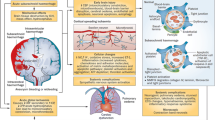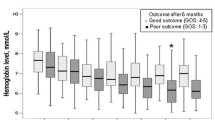Summary
We prospectively analysed treatment results in patients with severe subarachnoid haemorrhage (SAH) who underwent early aneurysm surgery, and were managed by dehydration therapy. We studied a total of 31 patients with poor-grade SAH including 18 in grade IV, and 13 in grade V according to the WFNS classification system. Patients who were older than 70 years of age, or those with an intracerebral haemorrhage or absent brainstem response were excluded from this study. At surgery, clot evacuation from the peribrainstem cisterns with/without external decompression was performed following obliteration of the aneurysmal neck. In the early postoperative period, patients were maintained in negative water balance using osmotic diuretics. When delayed ischaemic deficits had manifested themselves, the pulmonary wedge pressure and/or central venous pressure was immediately increased by the rapid injection of albumin until hypovolaemia reverted to normovolaemia with the continuous administration of dobutamine. The outcome at 3 months was good recovery in 16 (52%) patients, moderate disability in 3 (10%), severe disability in 5 (16%), a vegetative state in 1 (3%), and death in 6 (19%). We thought that early aneurysm surgery and postoperative dehydration therapy in the acute stages of brain oedema resulting from primary brain damage are effective in the treatment of patients with severe SAH but reversilbe primary brain damage.
Similar content being viewed by others
References
Auer LM, Schneider GH, Auer T (1986) Computerized tomography and prognosis in early aneurysm surgery. J Neurosurg 65: 217–221
Bailes JE, Spetzler RF, Hadley MN, Baldwin HZ (1990) Management morbidity and mortality of poor-grade aneurysm patients. J Neurosurg 72: 559–566
Disney L, Weir B, Grace M (1988) Factors influencing outcome of aneurysm rupture in poor-grade patients: a prospective series. Neurosurgery 23: 1–9
Doi M, Nishizawa Y, Tuiki K, Miura K, Koujou T, Saiki I, Kanaya H (1989) A clinical study of good recovery cases from severe stage (Hunt-Kosnik grade IV and V) of ruptured cerebral aneurysm. Stroke Surg (Tokyo) 17: 209–213 (Jpn)
Drake CG (1988) Report of World Federation of Neurological Surgeons Committee on a universal subarachnoid hemorrhage grading scale. J Neurosurg 68: 985–986 (Letter)
Hijdra A, Gijn JV (1982) Early death from rupture of an intracranial aneurysm. J Neurosurg 57: 765–768
Jakobsen M, Overgaard J, Marcussen E, Enevoldsen EM (1990) Relation between angiographic cerebral vasospasm and regional CBF in patients with SAH. Acta Neurol Scand 82: 109–115
Jennett B, Bond M (1975) Assessment of outcome after severe brain damage. A practical scale. Lancet 1: 480–484
Kaku Y, Yonekawa Y, Tsukahara T, Kazekawa K (1992) Superselective intra-arterial infusion of papaverine for the treatment of cerebral vasospasm after subarachnoid hemorrhage. J Neurosurg 77: 842–847
Kassell NF, Helm G, Simmons N, Phillips CD, Cail WS (1992) Treatment of cerebral vasospasm with intra-arterial papaverine. J Neurosurg 77: 848–852
Klafta LA Jr, Hamby WB (1969) Significance of cerebrospinal fluid pressure in determining time for repair of intracranial aneurysms. J Neurosurg 31: 217–219
Knuckey NW, Fox RA, Surveyor I, Stokes BAR (1985) Early cerebral blood flow and computerized tomography in predicting ischemia after cerebral aneurysm rupture. J Neurosurgery 62: 850–855
Kusske JA, Tuner PT, Ojemann GA, Harris AB (1973) Ventriculostomy for the treatment of acute hydrocephalus following subarachnoid hemorrhage. J Neurosurg 38: 591–595
Laumer R, Steinmeier R, Gonner F, Vogtmann T, Priem R, Fahlbusch R (1993) Cerebral hemodynamics in subarachnoid hemorrhage evaluated by transcranial Doppier sonography. Part 1. Reliability of flow velocities in clinical management. Neurosurgery 33: 1–9
Maroon JC, Nelson PB (1979) Hypovolemia in patients with subarachnoid hemorrhage: therapeutic implications. Neurosurgery 4: 223–226
Miyagami M, Kushi H, Sugawara T, Satoh K, Tsubokawa T (1989) Clinical analysis of severe ruptured aneurysm admitted within one hour after onset. Stroke Surg (Tokyo) 17: 151–156 (Jpn)
Mizuno M, Yasui N, Suzuki A, Hadeishi H, Nakajima S, Sampei T, Ohtsuki H, Sayama I (1991) Treatment for serious cases of ruptured intracranial aneurysms with severe subarachnoid hemorrhage. Neurological Surg (Tokyo) 19: 525–530 (Jpn)
Nelson RJJ, Roberts J, Rubin C, Walker V, Ackery DM, Pickard JD (1991) Association of hypovolemia after subarachnoid hemorrhage with computed tomographic scan evidence of raised intracranial pressure. Neurosurgery 29: 178–182
Origitano TC, Wascher TM, Reichman OH, Anderson DE (1990) Sustained increased cerebral blood flow with prophylactic hypertensive hypervolemic hemodilution (“Triple-H” therapy) after subarachnoid hemorrhage. Neurosurgery 27: 729–740
Pare L, Delfino R, Leblanc R (1992) The relationship of ventricular drainage to aneurysmal rebleeding. J Neurosurg 76: 422–427
Sekiguchi K, Sato S, Inoue A, Morii K, Sato M, Sorimachi T (1989) Surgical treatment of severe cases of ruptured intracranial aneurysm in the acute stage. Stroke Surg (Tokyo) 17: 246–249 (Jpn)
Shimoda M, Yamada S, Matsumae M, Yamamoto I, Tsugane R, Sato O (1988) Renal protection in acute neurosurgical diseases, effect of low dose dopamine with reference to acute renal failure and hypernatremia in patients with dehydration. Neurological Surg (Tokyo) 16: 851–856 (Jpn)
Shimoda M, Oda S, Tsugane R, Sato O (1993) Intracranial complications of hypervolemic therapy in patients with a delayed ischemic deficit attributed to vasospasm. J Neurosurg 78: 423–429
Shimoda M (1993) Complications of hypervolemic therapy. J Neurosurg 79: 798–801 (Letter)
Solomon RA, Post KD, McMurtry III JG (1984) Depression of circulating blood volume in patients after subarachnoid hemorrhage: implications for the management of symptomatic vasospasm. Neurosurgery 15: 354–361
Solomon RA, Fink ME, Lennihan L (1988) Early aneurysm surgery and prophylactic hypervolemic hypertensive therapy for the treatment of aneurysmal subarachnoid hemorrhage. Neurosurgery 23: 699–704
Steinmeier R, Laumer R, Bondra I, Priem R, Fahlbusch R (1993) Cerebral hemodynamics in subarachnoid hemorrhage evaluated by transcranial Doppler sonography. Part 2. Pulsatility indices: normal reference values and characteristics in subarachnoid hemorrhage. Neurosurgery 33: 10–19
Suzuki J, Yoshimoto T, Hori S (1979) Continuous ventricular drainage to lessen surgical risk in ruptured intracranial aneurysm. Surg Neurol 2: 87–90
Suzuki J, Onuma T, Yoshimoto T (1979) Results of early operations on cerebral aneurysms. Surg Neurol 11: 407–412
Yamakami I, Isobe K, Yamaura A, Nakamura T, Makino H (1983) Vasospasm and regional blood flow (rCBF) in patients with ruptured intracranial aneurysm: serial rCBF studies with the xenon-133 inhalation method. Neurosurgery 13: 394–401
Yasui N, Ito Z, Ohta H, Suzuki A (1982) Surgical problems and pathophysiology in severe cases with ruptured aneurysm in the acute stage. Acta Neurochir (Wien) 63: 163–174
Author information
Authors and Affiliations
Rights and permissions
About this article
Cite this article
Oda, S., Shimoda, M. & Sato, O. Early aneurysm surgery and dehydration therapy in patients with severe subarachnoid haemorrhage without ICH. Acta neurochir 138, 1050–1056 (1996). https://doi.org/10.1007/BF01412307
Issue Date:
DOI: https://doi.org/10.1007/BF01412307




